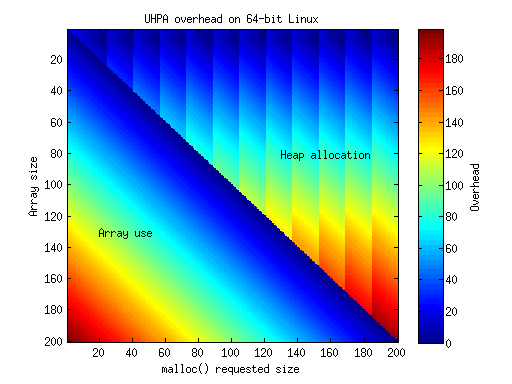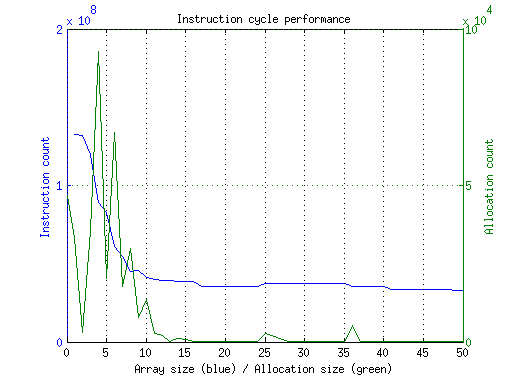This set of macros is intended to provide a simple means of treating a variable as a heap pointer or a fixed size array, depending on the size of the data being stored. It was borne out of the situation where the majority of calls to malloc for a struct member were ending up less than 8 bytes - i.e. the size of the 64-bit pointer. By using uhpa a great number of calls to malloc could be avoided. The downsize to this method is that you must always know the length of data that you are dealing with.
The data structure you provide must look something like:
typedef union {
void *ptr;
char array[MAX_ARRAY_SIZE];
} uhpa_u
This code really only makes sense if the data types you want to store are smaller than a pointer - the most obvious choice being bytes. All of these functions assume that the array is made up of single bytes.
You can change the type of ptr to match your needs, with the above caveat
about array. So make ptr a char*, uint8_t*, unsigned char*, ...
It should be possible to modify the code to work with arrays that have element sizes bigger than a byte.
Define MAX_ARRAY_SIZE to be as large as you want, depending on the size of
your commonly used data. Define MAX_ARRAY_SIZE to be sizeof(void *) if you
do not want to "waste" any memory per item - with the tradeoff that calls to
malloc will be more frequent because MAX_ARRAY_SIZE will only be 4 or 8
bytes, depending on your architecture.
There are three options for choosing the array size:
== sizeof(void *): no overhead with either array or heap usage.< sizeof(void *): basically pointless, guaranteed memory overhead when using array.> sizeof(void *): memory overhead will occur when using heap allocation.
The latter choice is the most interesting to consider. Increasing the size of the array will reduce calls to malloc because more cases of memory usage will be covered by the array, but when a request exceeds the available memory in the array then space is wasted. For example, if the array size is set to 10 and sizeof(void*) is 8, then the UHPA data type will be 10 bytes long and so requests of up to 10 bytes will use the array. A request of 11 bytes will require heap allocation and so the UHPA data type will be treated as a pointer. This means that of the 10 bytes of UHPA data type, only 8 will actually be in use, as the pointer. The remaining 2 bytes are overhead. Using a longer array size exacerbates this problem.
The per allocation overhead associated with using UHPA on a 64-bit Linux system
is shown in the image below, for varying MAX_ARRAY_SIZE and requested memory
sizes. The bottom left quadrant shows the region of memory used as an array,
and the top right shows the region when heap memory allocation is required.
The profile directory contains a program that attempts to allow you to carry out crude profiling of UHPA using e.g. callgrind. It also contains some example data which is an array of sizes of data to be allocated. This data was collected from the mosquitto broker instance running at test.mosquitto.org, then placed in random order. If you wish to use UHPA for your own use, getting your own data is recommended.
The image below shows the result of compiling this program with array size from 1-50, then running the result through callgrind and recording the instruction count. For reference, it also includes a histogram of the data lengths used when allocating. The instruction count drops rapidly for even small array sizes, then hits a plateau. It is clear that in this example the length of data used has a strong influence.
The image below shows a plot of the expected total memory used for the same test for different UHPA array sizes, and a plot of the expected total memory used if only heap allocation is used, both based on a current Linux 64-bit architecture.
Taking the results from both plots, if minimising memory usage is the aim then selecting a UHPA array size of 8 bytes is best. If saving instruction cycles is more important then a UHPA array size of 16 bytes gives better performance whilst only incurring a small memory penalty compared to 8 bytes. Choosing a large array size of 50 bytes gives the lowest instruction count in this example, but does so at the expense of around 50% increase in memory usage for only a fractional improvement in instruction count.
Note that if you are using strings, set size to be strlen(s)+1, so that the
null terminator is included, or use the _STR functions below.
Call to allocate memory to a uhpa variable if required.
- u : the uhpa data type that will have memory allocated or not, depending on "size".
- size : the length of the data to be stored, in bytes.
returns :
- 1 if memory was allocated successfully
- 0 if memory was not able to be allocated
- -1 if no memory needed to be allocated
Call to access (for read or write) a uhpa variable that has already had UHPA_ALLOC() called on it.
- u : the uhpa data type that has already had memory allocated.
- size : the length of the stored data, in bytes.
returns : an appropriate pointer/array address
Call to free memory associated with a uhpa variable. This is safe to call with a data structure that does not have heap allocated memory.
- u : the uhpa data type that has already had memory allocated.
- size : the length of the stored data, in bytes.
Convenience functions when working with strings. These are identical to the non-string versions, except that they increase the value of "size" by 1, to take into account the need for storing the 0 termination character.
UHPA_ALLOC_STR(u, size)
UHPA_ACCESS_STR(u, size)
UHPA_FREE_STR(u, size)
If you wish to use your own memory functions for alloc/free, #define both
uhpa_malloc and uhpa_free to your own functions.


